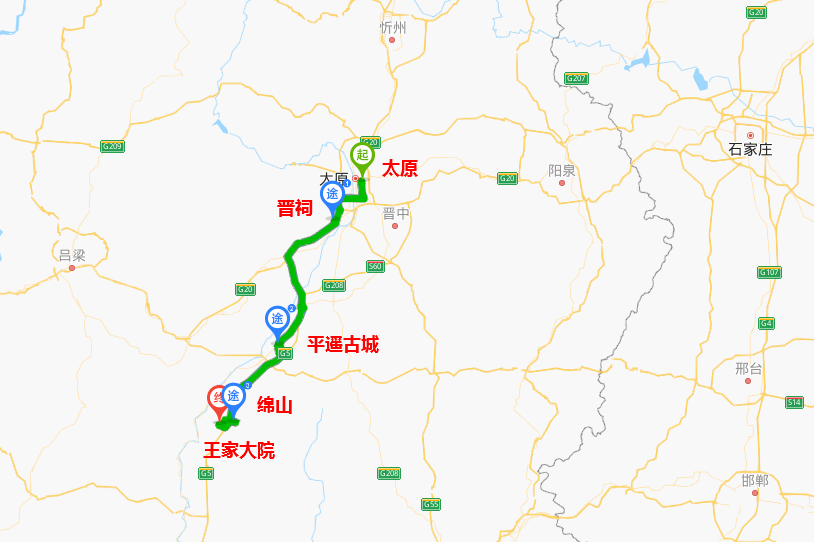
Self-driving route
Taiyuan - Jinci - Pingyao Ancient City - Mianshan - Wang Family Courtyard. About 200 kilometers, 3 days and 2 nights.

Self-driving recommendation
In the history of modern economic development since the Ming and Qing Dynasties, Shanxi merchants traveling across Europe and Asia have attracted worldwide attention. In particular, merchants from Jinzhong, represented by Pingyao and other places, promoted commerce and trade, and their business scope was all-encompassing. They took the lead in finance. Their bank accounts were distributed all over the world and they dominated for more than 500 years. The first thing to do when traveling to Shanxi is to understand Shanxi merchant culture.

Self-driving scenery
Jinci Temple
Jinci Temple is the only and precious historical and cultural heritage that integrates ancient Chinese sacrificial buildings, gardens, sculptures, murals and inscriptions. It is also a world-famous building, Garden and sculpture art center. The Fountain of Old Age, the Statue of the Maid and the Statue of the Virgin are known as the "Three Wonders of Jinci".


Pingyao Ancient City was built in the third year of Hongwu in the Ming Dynasty (1370). When coming to Pingyao Ancient City, some people like its ancient city walls; some like the lively streets of the Ming and Qing Dynasties; others like to wander into the antique alleys. Even the Loess Plateau, which is filled with loess, cannot bear to obscure its splendor and beauty. She is still gorgeous.


Mianshan, also known as Mianshang, was later named Jieshan because Jie Zitui (Jie Zitui), a famous minister of Duke Wen of Jin in the Spring and Autumn Period, took his mother to live in seclusion and was burned. There are 88 temples and more than 2,000 palaces in Mianshan. The Daluo Palace Taoist building complex alone covers an area of 30,000 square meters, the largest in the country. Mianshan has one wonder, two dangers and three beauties. People are crossing the bridge, and clouds are rising under their feet.



Some people say that Wang Family Courtyard is the Forbidden City in Shanxi. The architectural layout of the Wang Family Courtyard inherits the courtyard style of front hall and back bedroom that was formed during the Western Zhou Dynasty in China. It not only provides enough space for external communication, but also meets the requirements of the inner private atmosphere; it achieves the order of seniority and youth, and the distinction between men and women inside and outside. Each of the 88 courtyards in the fort has its own characteristics and none of them are alike.



D1: Depart from Taiyuan in the morning and visit Jinci Temple and surrounding areas in the morning. Travel to the ancient city in the afternoon. Overnight in Pingyao.
D2: Depart for Mianshan in the morning, and then go to Wang Family Courtyard. Overnight at Lingshi.
D3: Return on the morning of the third day. If you go on the weekend, you need to return the next day in the afternoon or evening.
Tips for self-driving
1. Guoyourou is a traditional local dish in Pingyao. Use selected lean meat, sizing and oiling, and stir-fry with natural black fungus, mushrooms and winter bamboo shoots. The color is golden and bright, the taste is salty and vinegary, and the texture is soft on the outside and tender on the inside. It is a rare delicacy.
2. Pingyao beef has a unique production process. It is ruddy in color, fragrant and delicious, delicious in taste, rich in nutrients, fat but not greasy, thin but not woody, and is suitable for all ages. Almost every restaurant in Pingyao has it, with many brands.
3. Oatmeal noodles are a very popular noodle dish in Pingyao. Roll the thin dough sheet into a hollow roll, stand it upright in the cage, and steam for about 10 minutes. Dip it in various soups and it tastes great!
4. Oil cake is one of the more high-end foods among Lingshi snacks. It is also a must-have for Lingshi people to celebrate festivals, entertain guests, and pay homage to the gods. No matter rich or poor, every household must eat cakes on the winter solstice, which means that luck will rise step by step in the coming year and life will be sweet.


